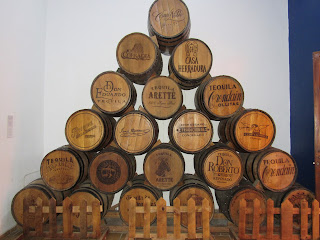As always, we continue to enjoy visiting museums, and try to hit the ones that fit our interests, so of course this museum was a must! It was small but informative.
Old school masher, effective, but has been replaced with more modern technolgy.
The agave heads were cooked in this small vessel.
The process of making tequila includes patience, dedication and time. It all starts with growing the agave plants, which are a succulent with large blue-green leaves that end in spiny tips. The hijuelos, which are young agave plant shoots, are planted and then grown for 5-7 years. During this time they are weeded, pruned and watched for pests. Watering is unnecessary because they benefit enough from the rainy season to achieve growth all year long. When the agave matures a tall flower stalk grows out of the center of the plant. The flowers are bell shaped, long lasting, and are shades of white, yellow or green.
Once the agave plants have matured the leaves are cut off, and the heads are removed from the ground. This harvesting process is so special that it is known worldwide as "jima" and is done by hand using a long sharp utensil called a "coa". This traditional method has been handed down from generation to generation. A good "jimadore" can harvest up to 3,000 kilos of agave a day.
After the heads are collected they are baked in order to extract its fermentable sugars. Traditionally, heads were baked in pits lined with rocks, but today they are baked in large stainless steel ovens called hornos.
After the heads or pinas are baked, they are crushed and shredded to extract the sweet juice which is called mosto. The mosto is extracted in one of two ways. The modern way is done using an industrial mechanical shredder, and also by the traditional method using a large stone wheel that crushes and juices the pena. These juices are now ready to be fermented.
The mosto must ferment into ethyl alcohol to become a spirit. The mosto is combined with yeast and water in large stainless steel fermentation tanks, or large wooden barrels before it is distilled.
The juices are distilled which purifies the liquid and concentrates the alcohol in the mixture. Tequila is typically distilled twice. The first distillation produces a cloudy liquid called the ordinario. The second distillation produces the clear silver tequilla which is ready to be aged and bottled.
Tequila is aged for at least 14 to 21 days. Silver of blanco tequila is aged the minimum time. Aged tequila comes in three types: reposado which is rested. It's aged for two months to one year, anejo which is aged for one to three years, and extra anejo is aged for over three years. There is also another type of tequila called oro or gold, which is a mix of silver tequila and reposado tequila.
And there you have it folks! A brief explanation on how tequila is made.
Our favourite is Cava de Oro. We drink it in wine glasses unadulterated at room temperature. It's very similar to drinking wine. Swirl the contents, look for fingers, smell its aroma, momentarily hold the delicious liquid in you mouth, and then down it slowly. It's truly an experience...and the best part is...no hangover, because face it, one glassful leads to another!
Salude!






No comments:
Post a Comment